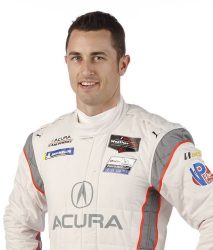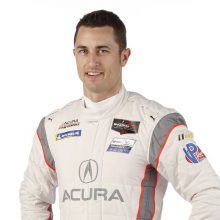Ask a pro
Receive advice directly from today’s top stars


Dane Cameron
Three-time IMSA Champion
Dane Cameron is one of the most successful IMSA sportscar drivers, taking his third championship in the series in 2019.
Cameron started his career in karting in 2005 and went on to become champion in the Star Mazda Series in 2007.
In 2009 Cameron switched his focus to sports cars full-time, going on to dominate the GTD class in IMSA with Turner Motorsport to take his first sportscars title in 2014.
He won his second championship in 2016, after a switch to Daytona Prototypes with Action Express Racing.
In 2020 Cameron will once again partner alongside Indy 500 champion Juan Pablo Montoya in the #6 Acura Team Penske Daytona Prototype, as they look to become the first back-to-back IMSA champions in five years.
Dane Cameron answers your questions!
-
Jake Wilson
What is the most challenging aspect of sharing a car with two other drivers? Do you all need to be on the same page setup-wise?




I think the most challenging part is the fitness of drivers, depending on the size of everybody. Being in long endurance races it’s very important to be comfortable in the car and to look after your body, and that can be a challenge sometimes if you have guys that are different sizes and some guys are more particular about what they like when it comes to pedals and seating position. Obviously trying to minimize the amount of cockpit inserts that you have when doing driver changes can be tricky, and then definitely for the overall speed of the program, being on a similar page for the setup is hugely important if one guy wants the car to be very loose, very free and the other drivers can’t drive it like that, well it’s no good if it makes one guy a tenth or two faster and it hurts the other guys by four or five-tenths if you want to call it that. So having some trust and relationship there to find a good middle ground where maybe one guy is comfortable to give up a touch of lap time maybe if it comes to that, but it brings your overall pace up for the whole day is kind of what you have to do to get the wins.
-
Dylan Avery
Going for your first Daytona 24 hours race win, is it good have to have team-mates that can bring a wealth of experience to the table?




I feel like I have a good amount of experience for the race. When I first started working with Juan (Pablo Montoya) I was very curious to know some things he could bring to the table and he definitely did bring some things from the success he had there a couple of times to kind of know what you thought you were missing a little bit. So it’s always good to have guys you can lean on to and more than anything I think our group is very experienced and we really trust each other, so when you have guys like that you have a lot of trust when they take their stints in the car and bring it back in one piece. I think that’s always one of the most interesting parts of endurance racing because as you bring people together from different programs inside of sportscar racing, Juan obviously has a lot of experience outside as well, it’s good to have some different opinions and some new ideas that can help push everything forward a bit as long as everyone is not trying to take each other in a different direction.
-
Dr. Ed Potkanowicz
Can you comment on how physical driving a Daytona Prototype (DPi) car can be?




The DPi’s are fairly physical these days, they are a lot quicker than they used to be, the pace obviously gets a little bit higher, the intensity goes up a little bit every year. Probably the hardest part is the neck now, with the new cars that we have the downforce is really high. When we get to Watkins Glen, Mosport, Road Atlanta is a really good one where its really high loads, really long corners, the G-Force is really high, so you need to have some good neck strength for sure and even on the brakes if you’ve been out of the car for a while and it’s somewhere that is not loaded with fast corners for the lateral stuff, you definitely feel it a bit on the back of your neck. So it takes a lot of time to learn all of that and I do a lot of work on the neck just to make sure that your neck doesn’t give up on the long races in particular. But having power steering, carbon brakes, the steering is not crazy heavy and really the brake pressure you need in a carbon material car is not huge. So it’s not too huge for that and the temperature is not crazy now that all the radiators and the heaters have been moved back, so it’s cooler inside the car than it was when we had the front radiator DPi cars six years ago.
-
Anonymous
How does the performance of the car change throughout the course of a 24 hour race?




What probably changes the most over the 24 hours is the track conditions and the weather. Typically at Daytona those first couple of stints are kind of the worst because it’s pretty hot in the afternoon, a little greasy, then as it cools off there is a lot of consistent running and rubber as it gets faster and faster, and then kind of into dusk and the early part of the night it can be really fast and the car feels really good, then the track almost gets too much of the rubber on it and it can get greasy. As far as the car on track, it doesn’t change a tonne, but it might be more or less suited to conditions that will make it feel better at certain parts of the race. Sometimes it can feel really good depending on the setup in the heat and go away at night or be a handful in the daytime in the heat and come back your way at night and that kind of takes away your experience. So, where you want the car to go or what part of the race you want to be strong. Obviously, you need to be strong at the end to finish, and then we have the brake bias, traction control, and anti-roll bars inside of the car that we can use to our advantage to chase the balance throughout the race.
-
Zac Cambell
How different is a race from a standing start to a race in the rolling start? Do you head into the first corner of a race differently?




Slightly, I haven’t done a standing start for a couple of years now! Standing starts are really fun but obviously in a way, more of a chance to go backwards if you have a bad one or if you get a really good one it’s sometimes a little easier to make a jump off the spot. Obviously if you’re second or third in a row, with a rolling start its kind of hard to go anywhere when everyone is going the same speed. You’re usually a bit closer together when you get to the first corner, so maybe a little bit more contact happens on a rolling start versus standing, whereas sometimes you can get a little bit spread out if guys around you get great starts. But obviously the start and restarts are always a great opportunity to go forward because everyone is really close together at a slightly lower speed, so it’s always a good chance to try and make up a spot of two before it’s stretched out.
-
Brad Sterner
Is there any specific fitness/nutrition plan you follow leading up to a race?




I would say for the race I try to ramp up my fitness over the offseason. We normally take a little bit of time off during the year, decompress a little bit, then it’s time to ramp back up for Daytona and try to be ready for this first race of the year where we do quite a lot of driving. I’ve done it enough now where I feel like I know which muscle groups I need to focus on such as my neck and things like that, to be ready and try to peak at the right time. Typically I work out when I’m at the race track just to be fully hydrated and ready to go, and nutrition-wise I just try to look out for what I eat throughout the year more or less, and on race week I try to make sure it’s all good stuff – nothing greasy or nasty like pizzas and burgers, you kind of wait until the race is over and you can enjoy a bit of junk food on the Sunday night after a good race.
-
Lewis Smith
Do you use any simulation tools to train yourself ahead of a race weekend? Like on iRacing or Project Cars?




I do a small amount with sim racing, not huge, a little bit with iRacing but depending on what type of car that you’re in they don’t always have your car or track. But I think if you have a good track that’s current, it can be really helpful and it seems to be getting more and more popular with every passing year. Genuine on-track time gets limited every year to try to save costs, so I think it’s a good way to get a little bit geared up. I tend to do a little bit just to see the track and refresh myself a little bit, but I don’t currently have access to the car that I’m normally racing so I don’t do a tonne, just enough to see a circuit. If I’m going somewhere new, I’ll do a little bit more just to have a better understanding of the racetrack, but once I have a good experience of the car and a good experience at that track I don’t do a huge amount to be honest.
-
Jesse
What was the path like to get to racing cars? What were some of the challenges you faced and how did you overcome them? What were some of the things that you did that made you stand out as a racer?




That’s a really popular question that I get. Obviously the kind of generic one for most people is go-kart racing, which then turns into single-seaters. I did Formula Ford 2000, the Star Mazda which is US Pro 2000 now I think, then Indy Lights, and then when I kind of got stuck there in the single-seater world I decided to make a switch full-time to sports cars from 2009. Once I got to sportscars it took a while to learn the ropes over there, make a network, and kind of work our way into better teams and better cars, and more competitive entries to win. The big challenge for everybody is always the money and the sponsorship, trying to raise some funds, to move forward is always the most difficult part and I think everyone’s personal situation and personal network can be different.
As far as standing out, being successful and winning is an easy way to get a little bit further than some other people but you have to always carry yourself the right way, do the right things, staying out of trouble as far as that stuff goes – now you can get into a lot of trouble on social media posting the wrong things or saying the wrong things, so always try to carry yourself as a professional. I think one thing that I didn’t do enough of when I was younger, was take the time to get to know everybody a bit more, team owners team mates, things like that to start to build the network a bit more. I really found that in sportscars, in particular, it really came down to more of having some people that you knew to support you or vouch for you, or that would want to drive for you, and if you were really fast they weren’t comfortable if they didn’t know you.
-
Dan
After your success in IMSA, are you tempted to race in the 24 Hours of Le Mans?




Yeah, Le Mans has definitely been high on my list for a number of years. It’s quite a difficult race to get entry to. It’s part of the full season of the World Endurance Championship, so a good portion of the seats are spoken for right out of the gate. Then driver rankings can sometimes make it a little difficult to jump to certain seats at times, but it’s something I’ve been working on quite hard for the last couple of years and again for this year. Hoping to get a chance to race there in the future for sure, but it’s something that’s been high on my list, one not only to get a chance to experience but two to hopefully achieve a victory there someday.
-
James Gibson
Which track would you most like to race on in IMSA that it doesn’t already go to?




The track that I would like to go to the most, it would be hard to narrow it down to one, but one racetrack that I really miss from years ago was the Cleveland Airport circuit. IndyCar and Champ Car used to race there on the airport, I used to love that place it was fast, bumpy, you had to be committed to go quick around there. It would probably make a decent sports car race, but as an event as a whole it was always really well attended and one of my favorite places to go and I definitely miss going back there and I think it would be a cool place to go to try something new for sportscars.
 Road Racing Drivers Club
Road Racing Drivers Club
 Share
Share







